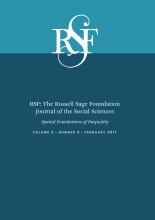Research Article
Open Access
From Bad to Worse: How Changing Inequality in Nearby Areas Impacts Local Crime
John R. Hipp, Charis E. Kubrin
RSF: The Russell Sage Foundation Journal of the Social Sciences February 2017, 3 (2) 129-151; DOI: https://doi.org/10.7758/RSF.2017.3.2.06
John R. Hipp
aProfessor in the Department of Criminology, Law, and Society and the Department of Sociology at the University of California, Irvine
Charis E. Kubrin
bProfessor in the Department of Criminology, Law, and Society and the Department of Sociology at the University of California

REFERENCES
- ↵
- Agnew, Robert
- ↵
- ↵
- Blau, Judith R., and
- Peter M. Blau
- ↵Brantingham, Paul J., and Patricia L. Brantingham. 1984. Patterns in Crime. New York: Macmillan.
- ↵
- Brownson, Ross C.,
- Christine M. Hoehner, ,
- Kristen Day, ,
- Ann Forsyth, , and
- James F. Sallis
- ↵
- Buck, Andrew J., and
- Simon Hakim
- ↵Bursik, Robert J. 1986. “Delinquency Rates as Sources of Ecological Change.” In The Social Ecology, edited by James M. Byrne and Robert J. Sampson. New York: Springer-Verlag.
- Bushway, Shawn D. 2011. “Labor Markets and Crime.” In Crime and Public Policy, edited by James Q. Wilson and Joan Petersilia. New York: Oxford University Press.
- ↵
- Crutchfield, Robert D
- ↵
- Deng, Yongheng,
- Stephen L. Ross, , and
- Susan M. Wachter
- ↵
- Dugan, Laura
- ↵
- ↵
- ↵
- ↵
- Harer, Miles D., and
- Darrell Steffensmeier
- ↵
- Hipp, John R
- ↵
- ↵
- Hipp, John R
- ↵
- ↵
- Hipp, John R., and
- Adam Boessen
- ↵
- Hipp, John R., and
- Cynthia M. Lakon
- ↵
- ↵
- Hipp, John R.,
- George E. Tita, , and
- Robert T. Greenbaum
- ↵
- Hipp, John R., and
- Daniel K. Yates
- ↵
- Kubrin, Charis E
- ↵
- Kubrin, Charis E., and
- John R. Hipp
- ↵
- Kubrin, Charis E., and
- Ronald Weitzer
- ↵
- Mast, Brent D., and
- Ronald E. Wilson
- ↵
- Mears, Daniel P., and
- Avinash S. Bhati
- ↵Merton, Robert K. 1968. Social Theory and Social Structure. New York: The Free Press.
- ↵
- Messner, Steven F., and
- Reid M. Golden
- ↵
- Messner, Steven F., and
- Kenneth Tardiff
- ↵
- Morenoff, Jeffrey D., and
- Robert J. Sampson
- ↵
- Morenoff, Jeffrey D.,
- Robert J. Sampson, , and
- Stephen W. Raudenbush
- ↵Openshaw, Stan, and Peter J. Taylor. 1979. “A Million or so Correlation Coefficients: Three Experiments on the Modifiable Areal Unit Problem.” In Statistical Applications in the Spatial Sciences, edited by Neil Wrigley. London: Pion.
- Pastor, Manuel, Jr..,
- Jim Sadd, , and
- John Hipp
- ↵
- Peterson, Ruth D., and
- Lauren J. Krivo
- ↵Peterson, Ruth D. 2010. Divergent Social Worlds: Neighborhood Crime and the Racial-Spatial Divide. New York: Russell Sage Foundation.
- ↵
- Popkin, Susan J.,
- Michael J. Rich, ,
- Leah Hendey, ,
- Chris Hayes, ,
- Joe Parilla, , and
- George C. Galster
- ↵
- Putnam, Robert D
- ↵
- Raleigh, Erica, and
- George Galster
- Reardon, Sean F.,
- Stephen A. Matthews, ,
- David O’Sullivan, ,
- Barrett A. Lee, ,
- Glenn Firebaugh, ,
- Chad R. Farrell, , and
- K. Bischoff
- ↵
- Rice, Kennon J., and
- William R. Smith
- ↵Rossmo, D. Kim. 2000. Geographic Profiling. Boca Raton, Fl.: CRC Press.
- ↵
- Rountree, Pamela Wilcox, and
- Kenneth C. Land
- ↵
- ↵
- Sampson, Robert J.,
- Stephen W. Raudenbush, , and
- Felton Earls
- ↵
- Schwartz, Amy Ellen,
- Scott Susin, , and
- Ioan Voicu
- ↵
- ↵
- Sherman, Lawrence W.,
- Patrick R. Gartin, , and
- Michael E. Buerger
- ↵
- Smith, William R.,
- Sharon Glave Frazee, , and
- Elizabeth L. Davison
- ↵
- Stucky, Thomas D., and
- John R. Ottensmann
- ↵
- Taylor, Ralph B., and
- Jeanette Covington
- ↵
- Thaler, Richard
- ↵
- ↵Weisburd, David, Elizabeth Groff, and Sue-Ming Yang. 2012. The Criminology of Place. New York: Oxford.
- ↵Weisburd, David, and Tom McEwen. 1998. “Crime Mapping and Crime Prevention.” In Crime Prevention Studies, vol. 8, edited by Ronald V. Clarke. Monsey, N.Y.: Criminal Justice Press.
- ↵
- Xie, Min, and
- David McDowall
- ↵
- Xie, Min
In this issue
From Bad to Worse: How Changing Inequality in Nearby Areas Impacts Local Crime
John R. Hipp, Charis E. Kubrin
RSF: The Russell Sage Foundation Journal of the Social Sciences Feb 2017, 3 (2) 129-151; DOI: 10.7758/RSF.2017.3.2.06
Jump to section
Related Articles
- No related articles found.
Cited By...
- No citing articles found.





